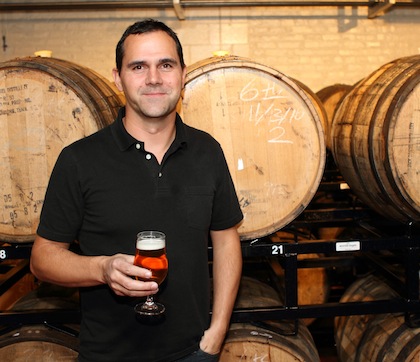Imperialization
The boldest move in the world of pilsner, however, has come with the introduction of the imperial or double pilsner, which, in the light of everything that has happened in the U.S. in the past few years, should come as no surprise. Yet, there’s a dilemma here―a well-made pilsner is a high-wire balancing act between gently toasted bready notes, cool fragrant and often aromatic floral wafts on the breeze and―depending on whether it’s the Bohemian or Bavarian model―a crystalline or fuller mouth feel. Ramp up the alcohol and you risk putting your brewing boot through a masterpiece of subtlety. Yet, the ones I have tried somehow work.
Earlier this year, I devoured Alchemist’s Your Mother at the Vermont Brewers Association’s beer festival in Burlington VT. With 65 bittering units and an alcoholic strength of 7 percent ABV, this was a boisterous German-influenced beer. Lagering had taken place for a staggering 14 weeks, while pilsner malt and noble hops had gone into the boil. Lemon/grapefruit notes on the nose were beamed up onto the palate along with a light peachy/apricot fruitiness, and a softly floral and piney character; the finish was long and appetizingly bitter. It was glorious and I went back for more.
Steven Pauwels took one step further and produced an imperial pilsner in collaboration with Orval’s brewmaster Jean-Marie Rock. “When he and I started discussing it,” he says, “his first input was that he wanted to brew a pilsner. He wanted to revive a beer that he had brewed at an earlier brewery in his career in Belgium. We, on the other hand, wanted to make it bigger or stronger. To me an imperial pilsner has all the characters of a pilsner beer: crisp, balance between malt and hops, floral hop character, easy drinking and not cloying or sweet. There also is no alcohol perception in pilsner and there shouldn’t be any in an imperial pilsner.”
I did get shown a bottle when I visited Rock at Orval in 2010, but it was empty.
Pilsner has taken a long journey from the moment Josef Groll turned up in Pilsen from Bavaria. He wouldn’t have known that the beer he eventually came up with would take over the world and, given his nature, he probably wouldn’t have been too impressed. However, there’s one variant of the beer that he and the burgomasters might have been familiar with, given the problems they had with beer―sourness. But if you’re thinking that pilsner-plus-funk is the next big thing, hold on: read what Doug Odell has to say.
“We have an oak-aged pilsner,” he says. “The idea sprang from wanting to use the virgin oak barrels we age our Woodcut beers in, for a second time. We tried about four of our regular beers including the Double Pilsner. I would say it added a complimentary nutty, vanilla character to the beer.” However, and here comes the pay-off. “We tried adding some Brettanomyces to the Double Pilsner for secondary fermentation, but it kind of overwhelmed the flavor. I don’t think a sour pilsner would work.”
Is there a brewer out there ready to prove him wrong?











Imperial Pilsner. What is it? Oh yeah, a stronger sort of pale lager. Hmmm? Where have I seen that? Wait a second! In Germany, and it’s called Helles Bock, and in the Czech Republic and it’s called Světlý Speciál! Stop “imperialising” and/or “doubling” things for effings sakes!
Good article otherwise.
Because SABMiller have such marketing clout this eurobeer, which is brewed in Russia and Poland as well, and tasted just the same, gets drank far to uncritically.
Pilsner simply means from Pilsen region and not long ago there were many such beers, but by closure or amalgamation the mighty SABMiller has crushed all that into its Eurokeg. Now some small “from pilsen” beers fight back.